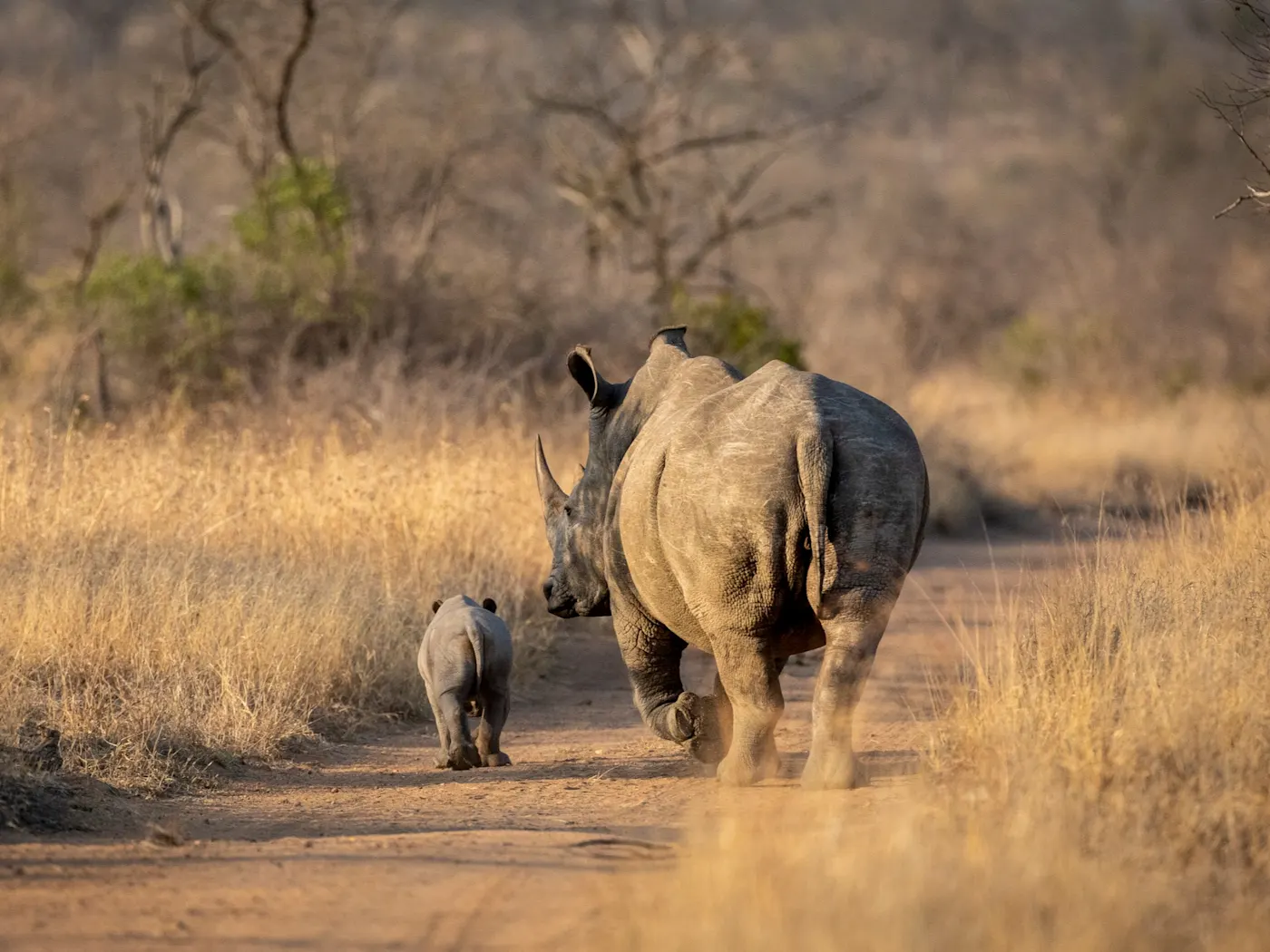
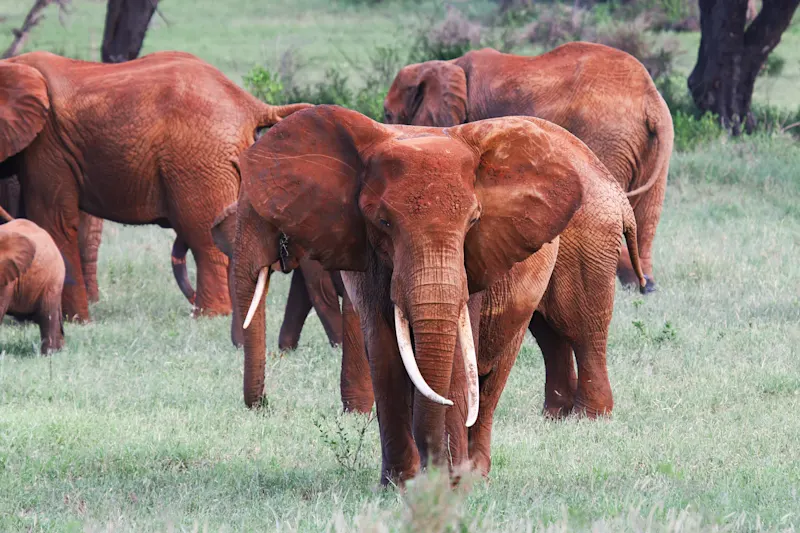
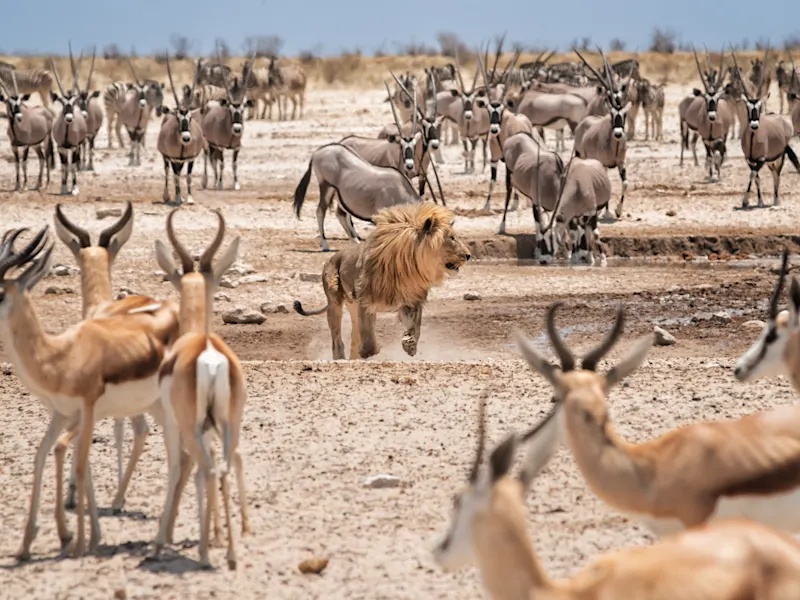
Safari Index: The 50 best national parks in Africa
A comparison of Africa's national parks
Africa’s national parks are as diverse as the continent itself—from Tanzania’s dry savannas and South Africa’s plains to Botswana’s wetlands, Namibia’s deserts, and Uganda’s misty mountain forests. Each park offers a truly unique adventure. While the Big Five – lion, elephant, leopard, rhino, and buffalo – aren't guaranteed everywhere, you might encounter other extraordinary species. So, which safari truly offers the most well-rounded experience and is genuinely worth the journey?
Our wildlife travel experts analyzed 50 national parks and reserves in Southern Africa to provide definitive rankings. We focused on what matters most to safari-goers: entrance fees, accommodation, safety, ideal travel seasons, the chances of seeing the Big Five, and each park's biodiversity and conservation efforts.
This extensive research has resulted in a reliable ranking, offering safari travelers clear direction to the most fulfilling and environmentally responsible wildlife adventures across Africa.
Africa's Top 3 Safari Parks
1. Serengeti National Park, Tanzania
The Serengeti is safari at its finest: vast plains, endless skies, and untouched wilderness. It tops our Safari Index for its standout biodiversity, strong conservation management, and the diverse ways to experience it. A day pass is around $70.
More than 570 species live here, including all Big Five. The showstopper is the Great Migration, when millions of wildebeest and zebras move between the Serengeti and the Masai Mara in search of fresh grazing and water.
You can take the Serengeti from multiple angles: classic game drives to elephant waterholes, giraffe feeding grounds, and lion prides; scenic flights by light aircraft for a sweeping bird’s-eye view; or a sunrise hot-air balloon drifting quietly over herds that seem to run to the horizon.
All of it is underpinned by clear conservation rules and thoughtful visitor management—so the Serengeti stays what it should be: an intact piece of wild Africa.
Best Travel Time: June-October and January-February
Recommended arrival
Domestic flight to Seronera (SEU) – Direct flights from Arusha (ARK) or Kilimanjaro (JRO); lodge transfers are usually arranged.
Overland by 4x4 vehicle from Arusha – 5-6 hours driving time, depending on the season and road conditions.
Combined Route: As a classic North Tanzania safari route: Tarangire – Ngorongoro – Serengeti.
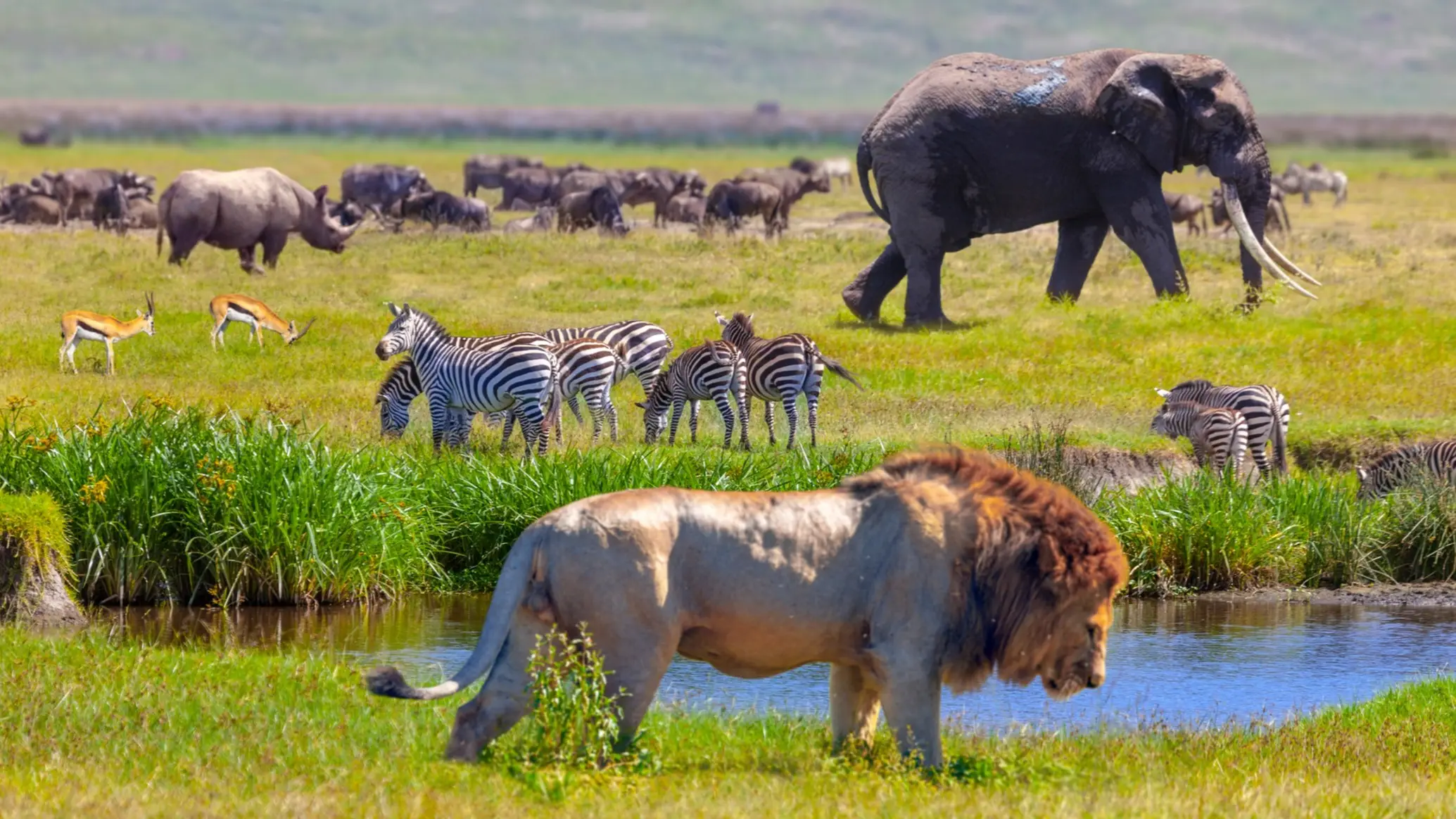
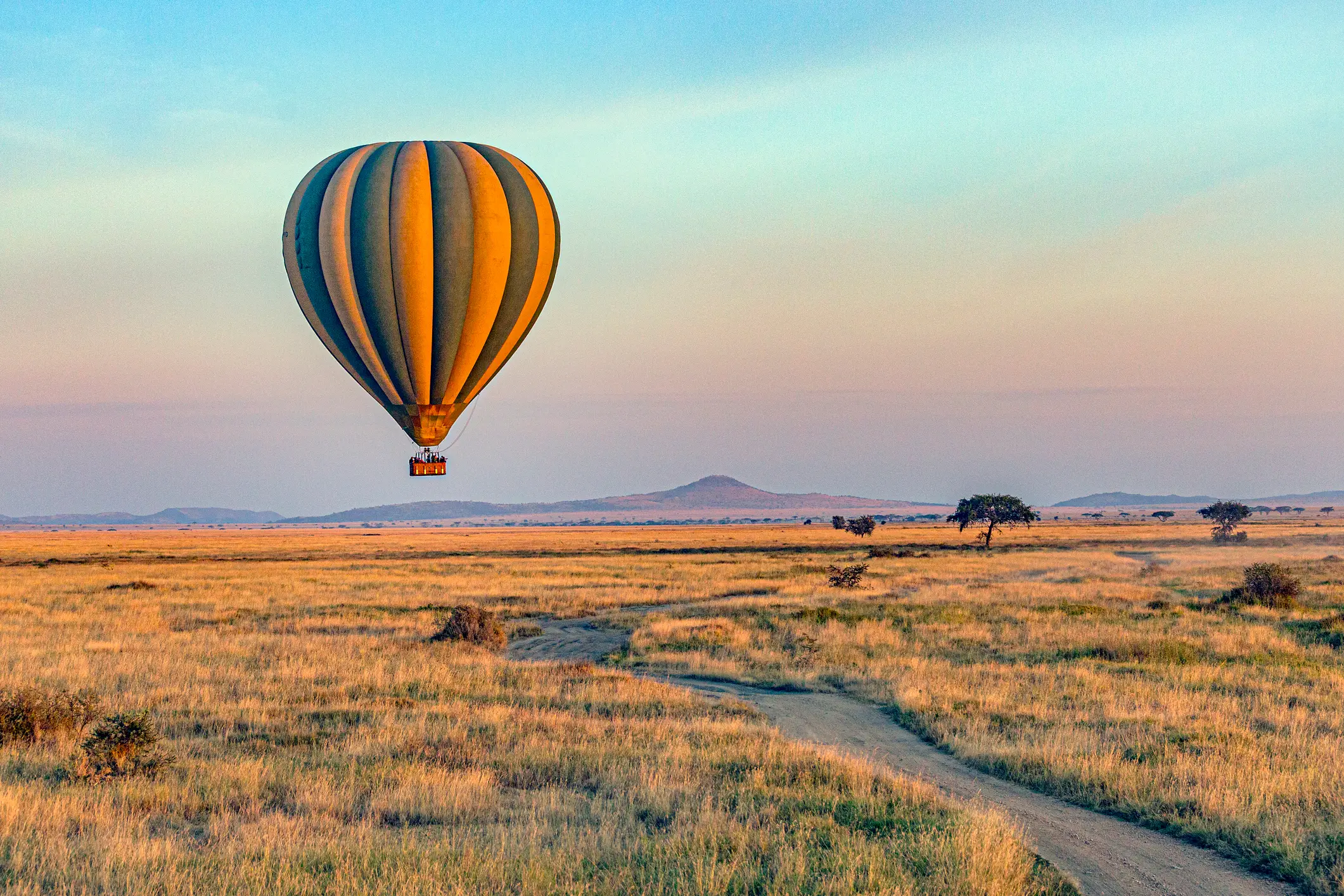

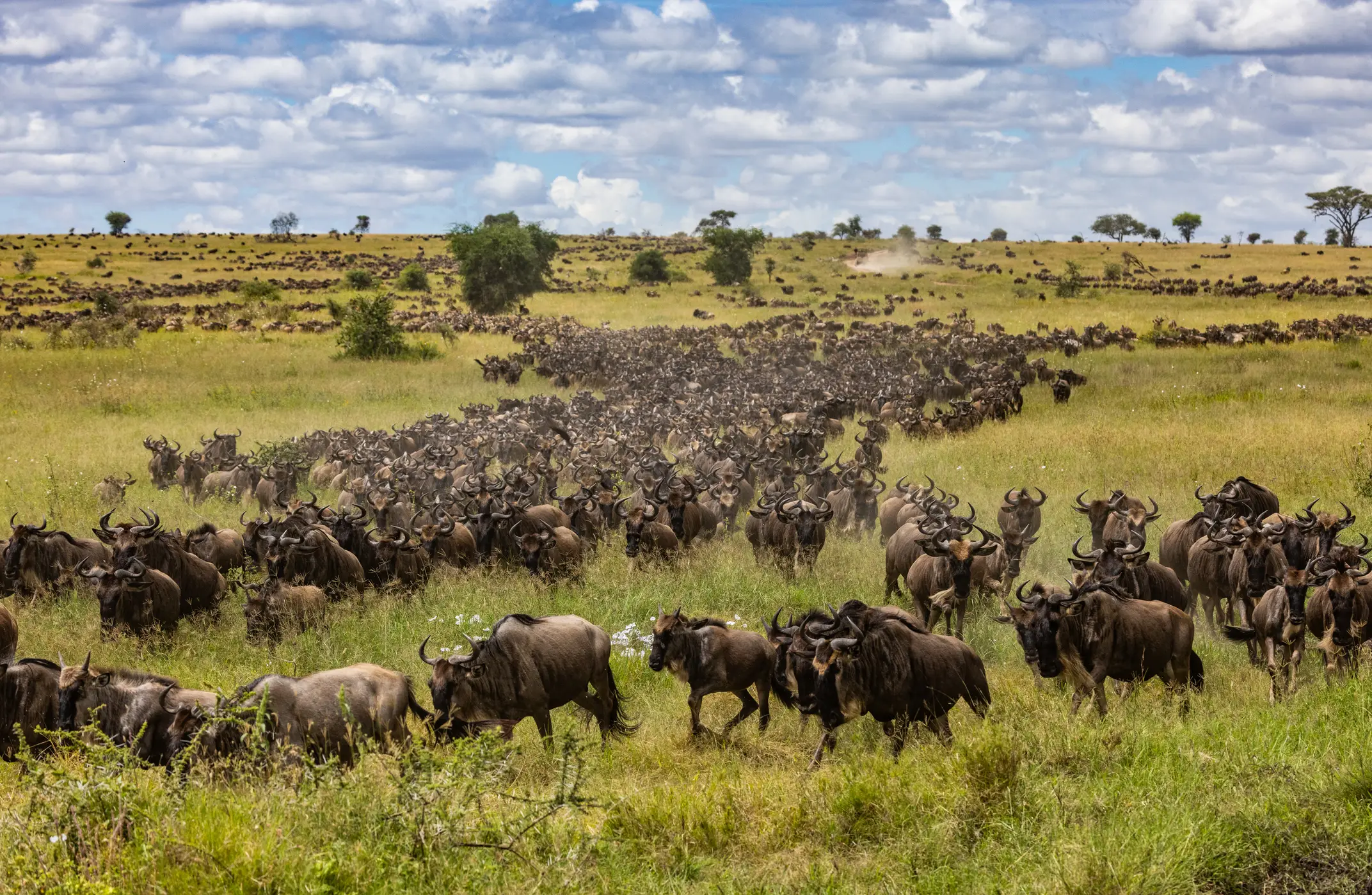
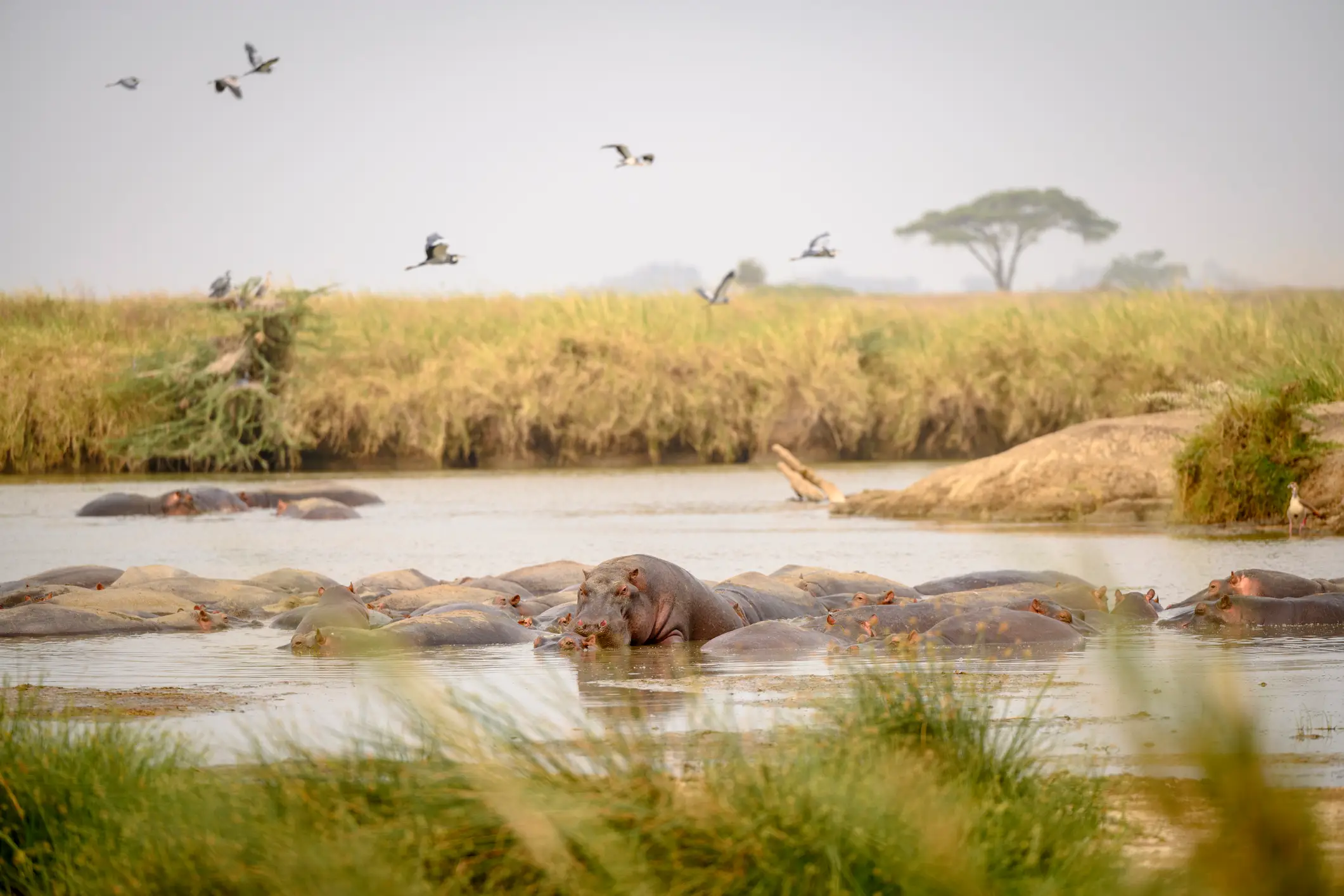
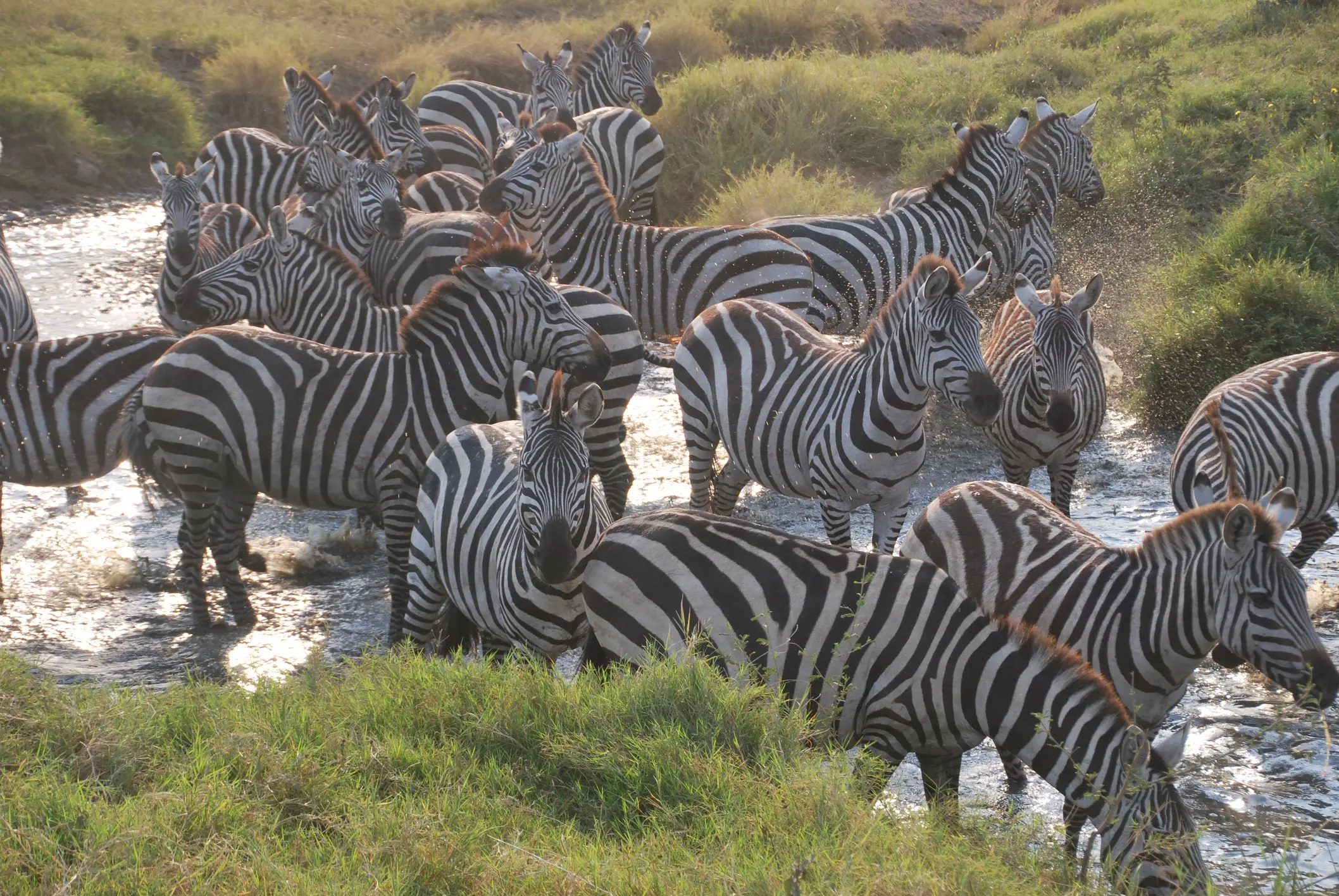
2. Tsavo National Park, Kenya
Touch down in Tsavo and it feels different right away: wilder, dustier, more elemental. Kenya’s largest park is split into Tsavo East and Tsavo West, two vast landscapes of lava fields, open savanna, and acacia.
Tsavo East is famous for its red elephants, their hides tinted by iron-rich dust. You may also hear about the hirola antelope, one of Africa’s most endangered, with last refuges in Kenya’s northeast. Tsavo isn’t about constant action so much as unforced encounters: sightings that feel spontaneous, and create unique experiences.
Highlights range from game drives along the Galana River—crocodiles and hippos sharing the banks—to walking safaris in Tsavo West, past volcanic hills and the glass-clear pools of Mzima Springs. For a slower pace, watch elephant herds at Aruba Dam or stay for sunset over the dark cones of the Chyulu Hills.
With its sheer size and seclusion, Tsavo (day pass ~$52) remains an under-the-radar choice for travelers who want safari in its raw, original form, well away from the crowds.
Best Travel Time: July - October, December - March
Recommended Arrival
Overland by car: approx. 5 hours from Nairobi or approx. 4 hours from Mombasa via the well-maintained A109.
Domestic flight to Voi Airstrip or Tsavo West Airstrip: regular connections from Nairobi or Mombasa.
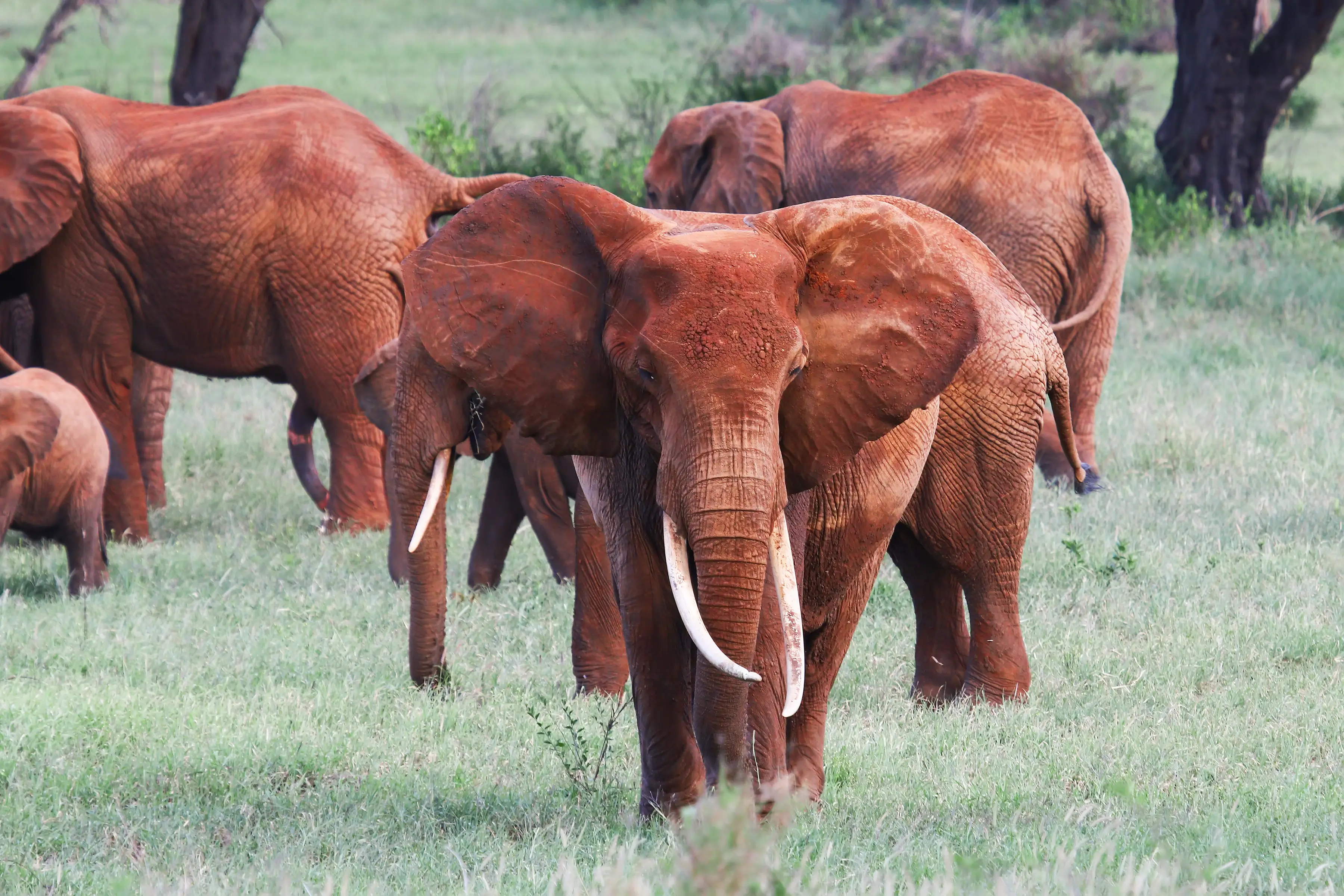

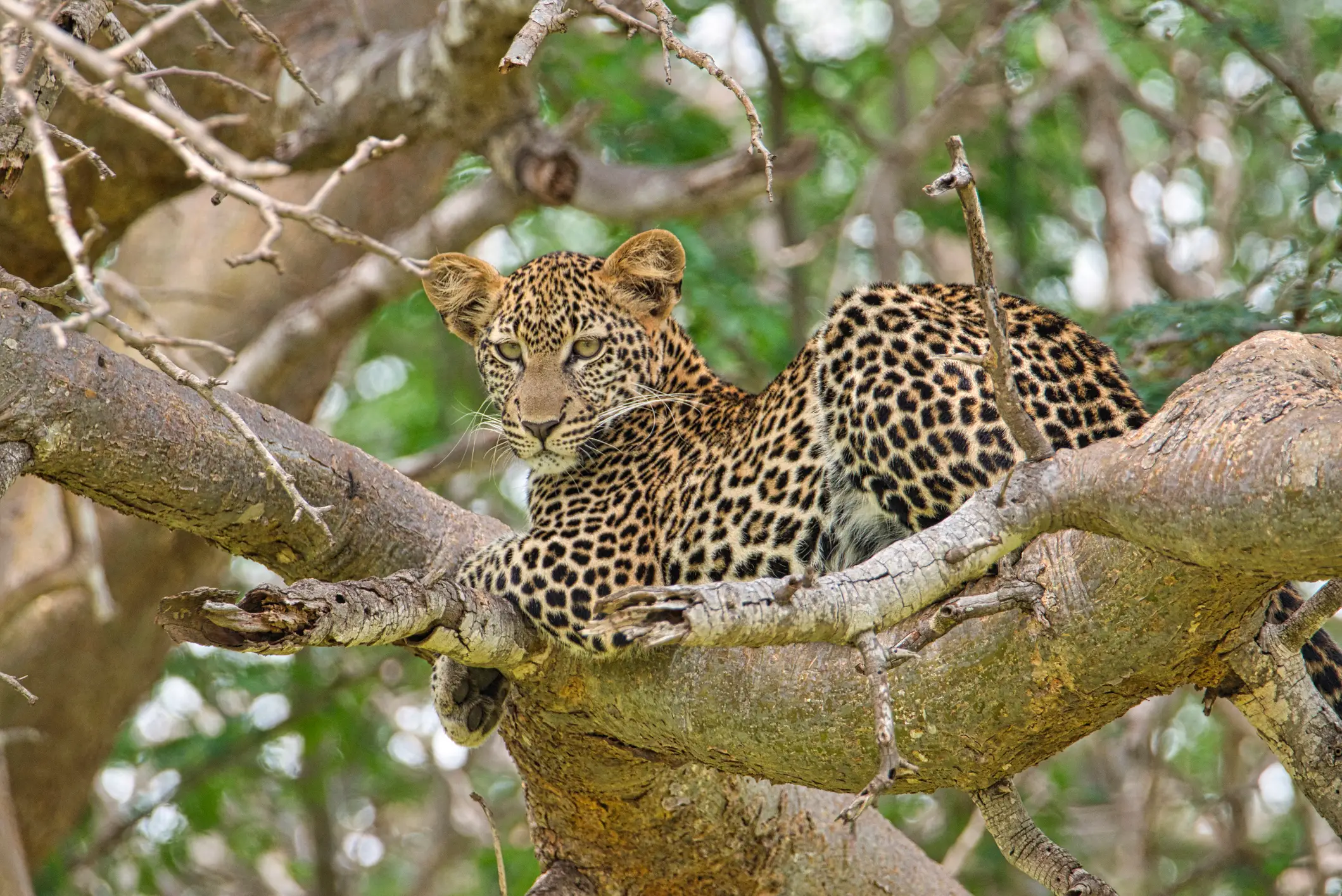
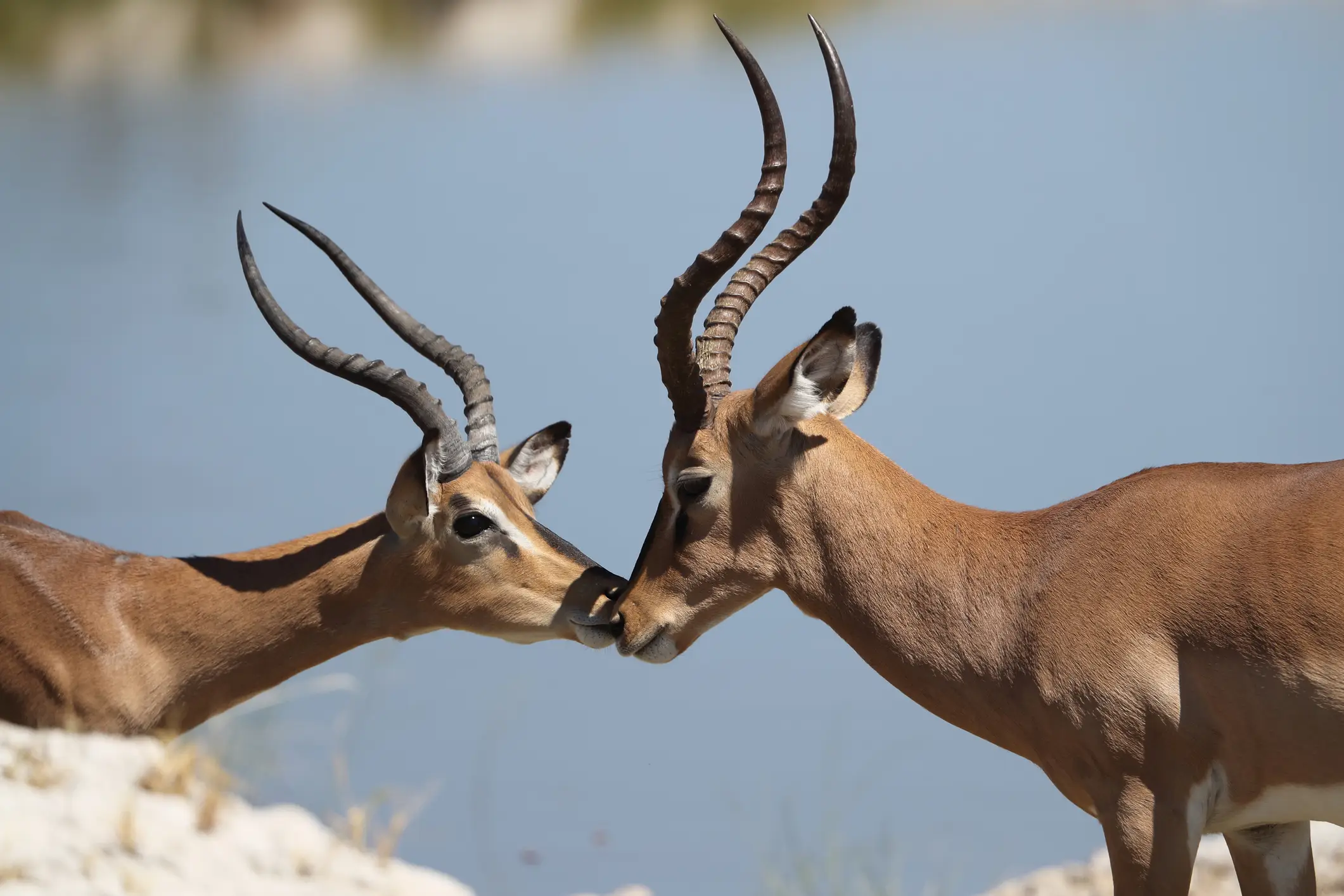
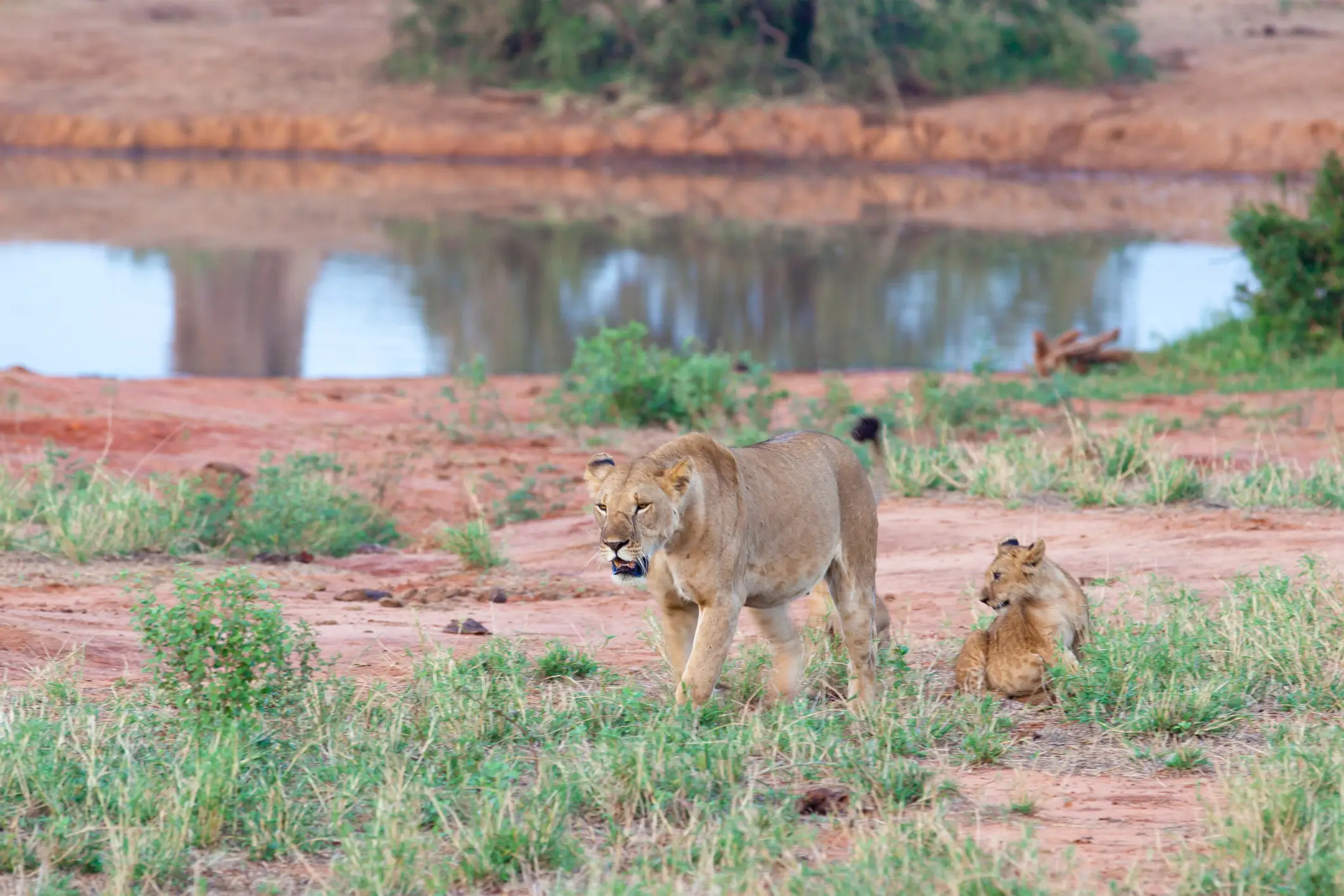
3. Moremi Game Reserve, Botswana
Choose Moremi and your safari will be different: not dusty tracks but water channels, papyrus-fringed banks, and green islands. The reserve sits at the heart of the Okavango Delta, one of the world’s largest inland deltas and a UNESCO World Heritage Site.
At roughly 2,000 square miles, Moremi is smaller than many headline parks, yet its variety is remarkable. Savanna meets swamp, creating rich habitat for elephants, lions, leopards, hippos, and a wealth of birdlife. It’s also one of Africa’s best places to see native African wild dogs.
A day pass is about $20 per person, and staying for a few nights is absolutely recommended. With numerous lodges and camps in and around the reserve, you’re never far from the action. The signature experience is exploring the Okavango by Mokoro—a traditional canoe, which slips through the channels in silence. You can also head out on other boat trips along wider waterways or take classic game drives across the dry islands.
Best Travel Time: July - October
Recommended arrival
Domestic flight to Maun is common, followed by a small plane or 4x4 vehicle into the reserve. Overland by car is significantly more time-consuming and therefore uncommon.
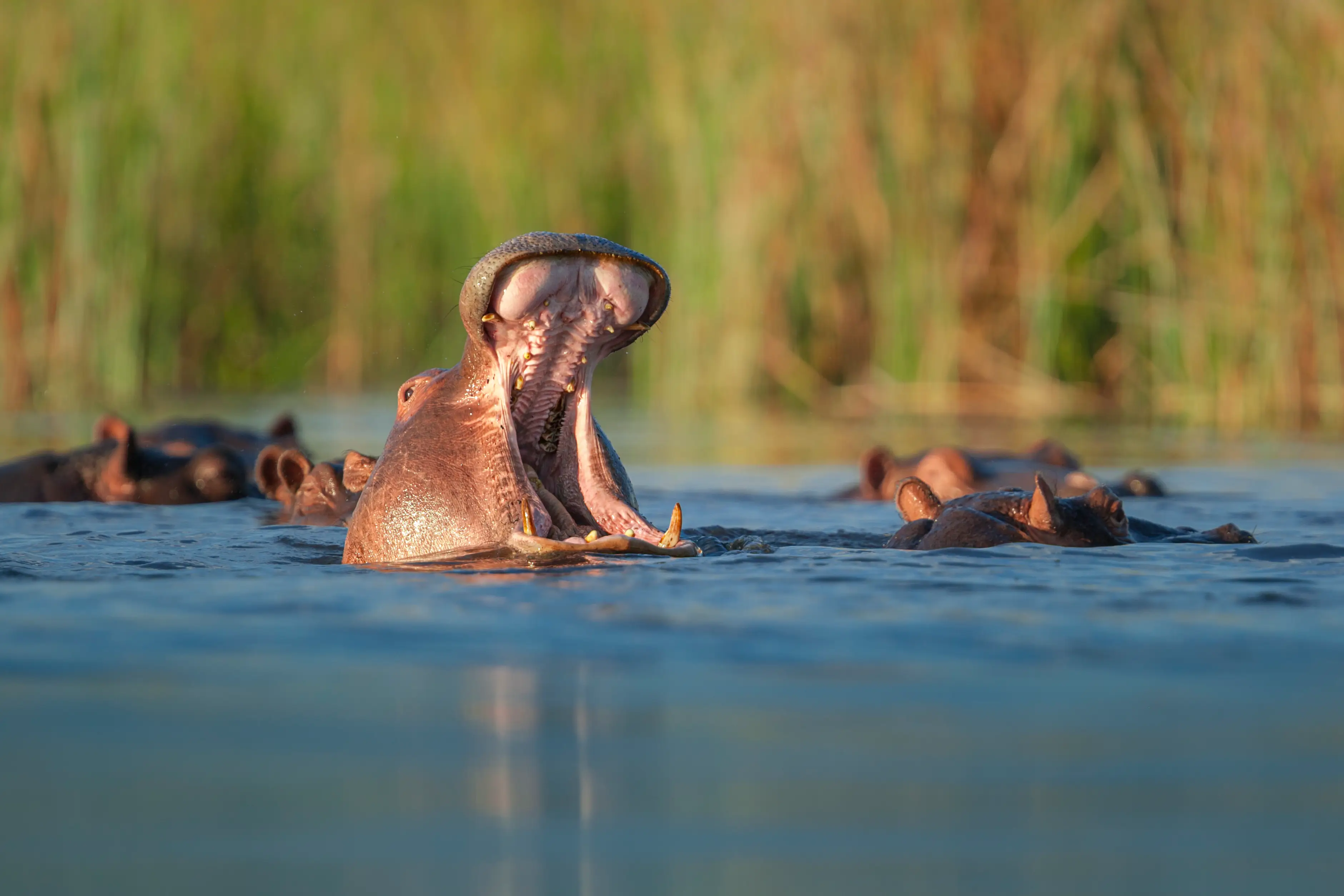
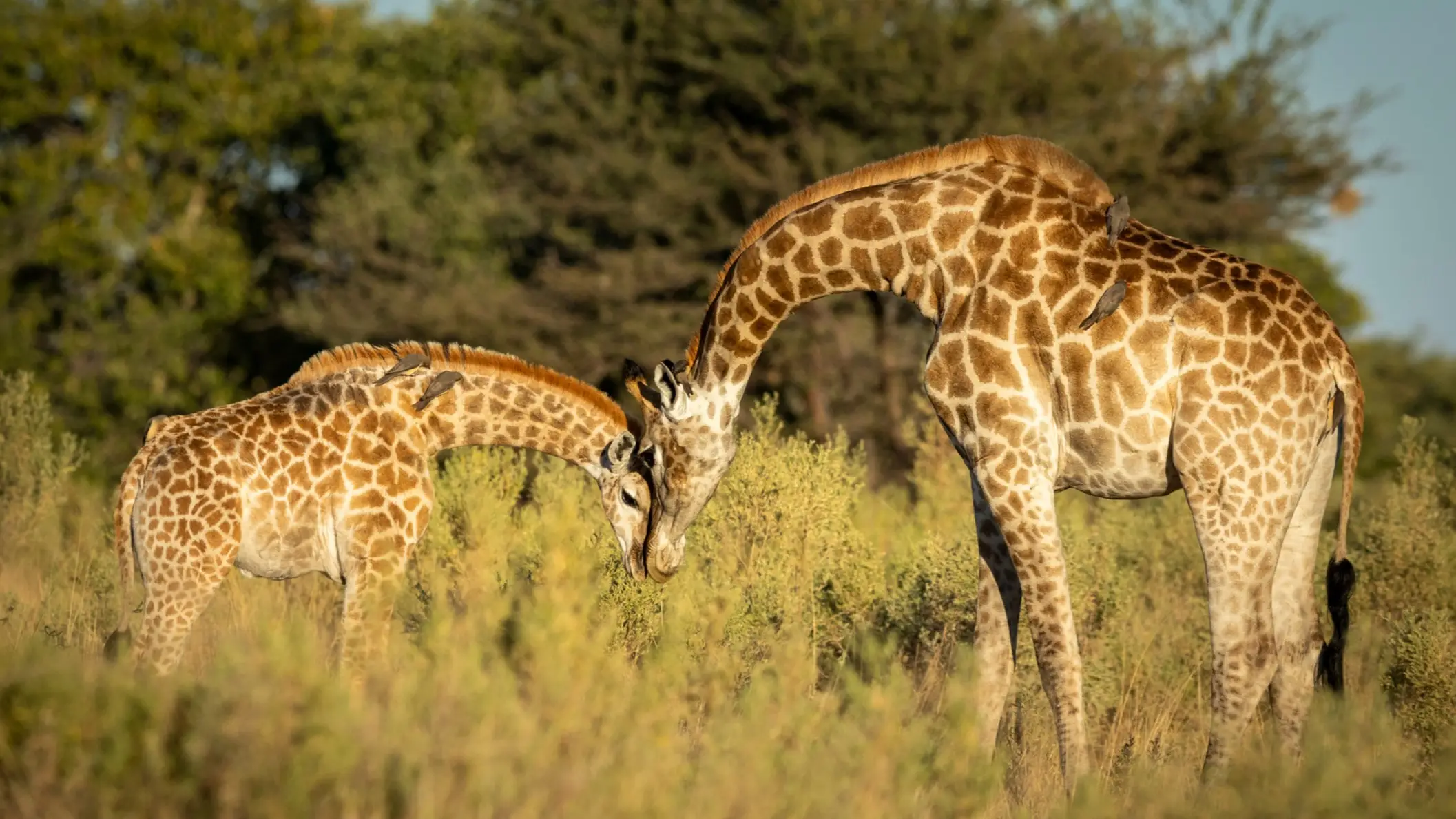
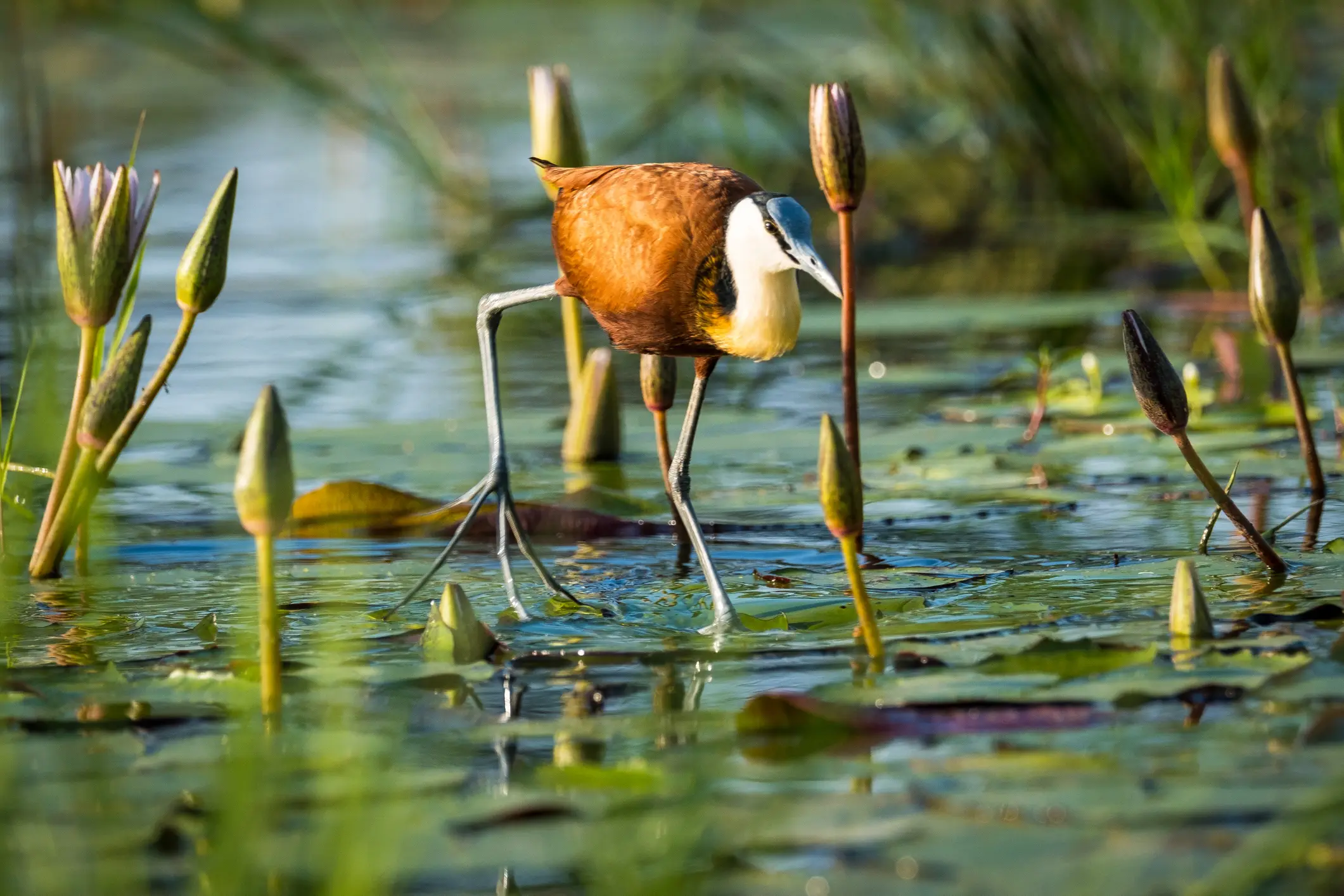
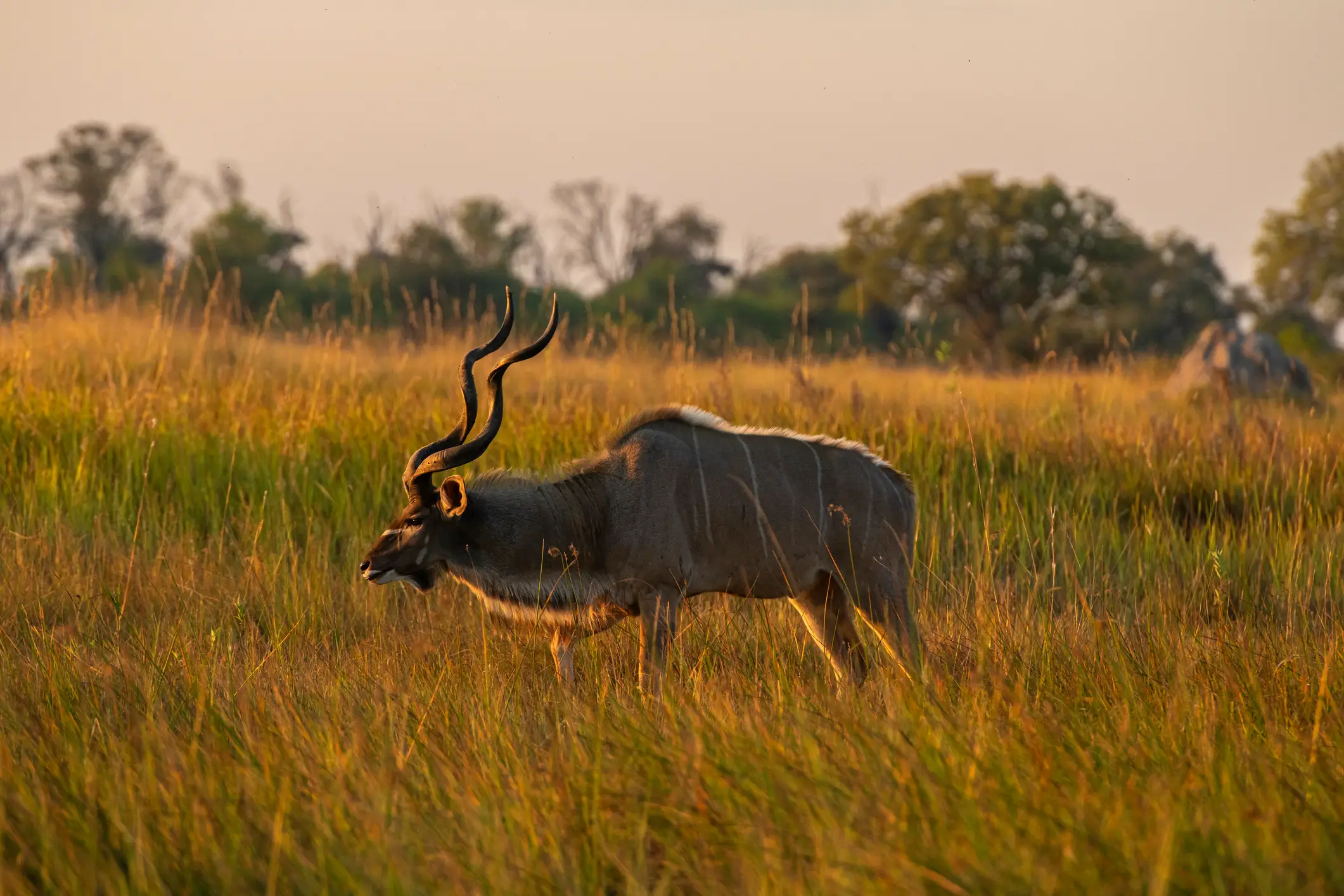
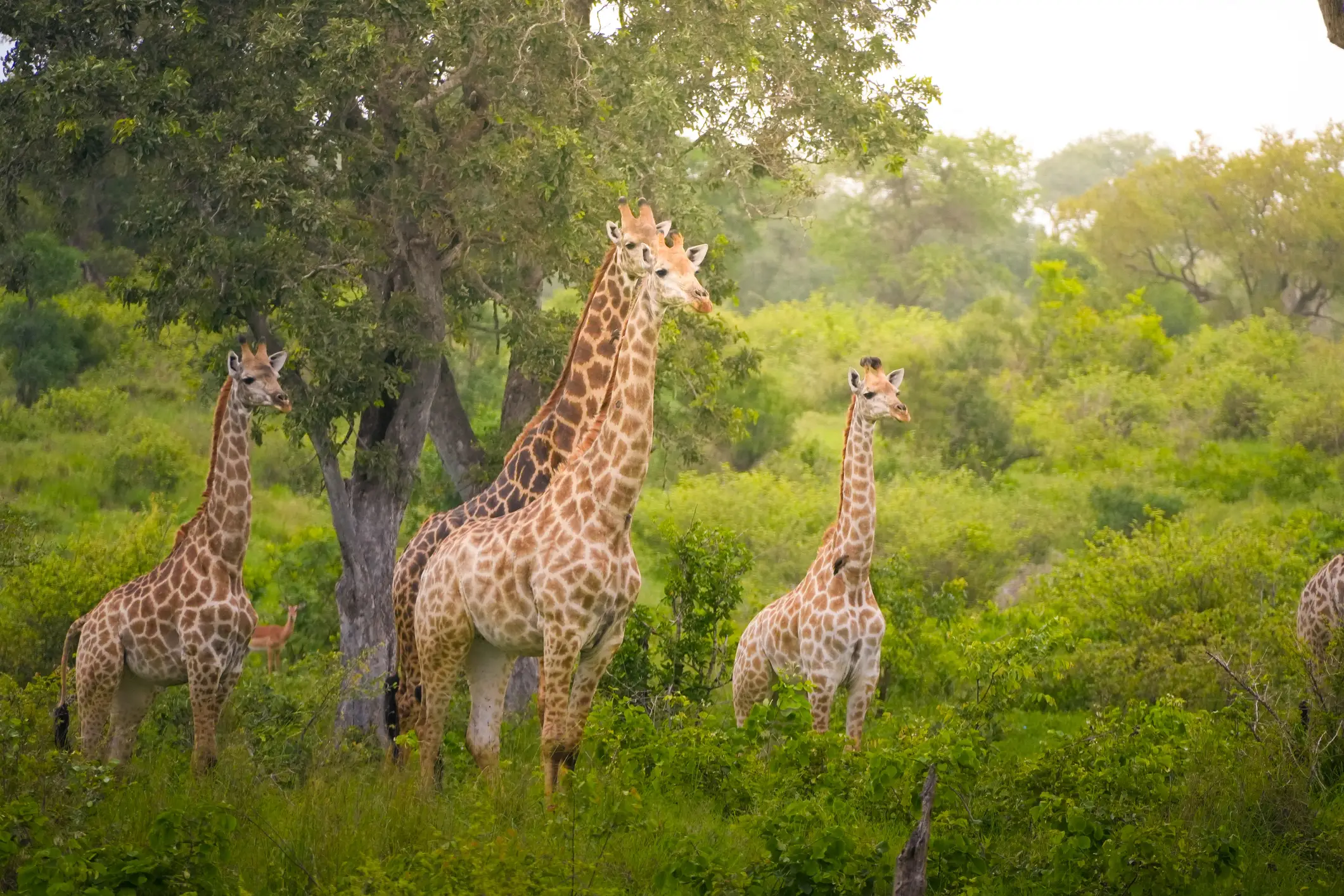
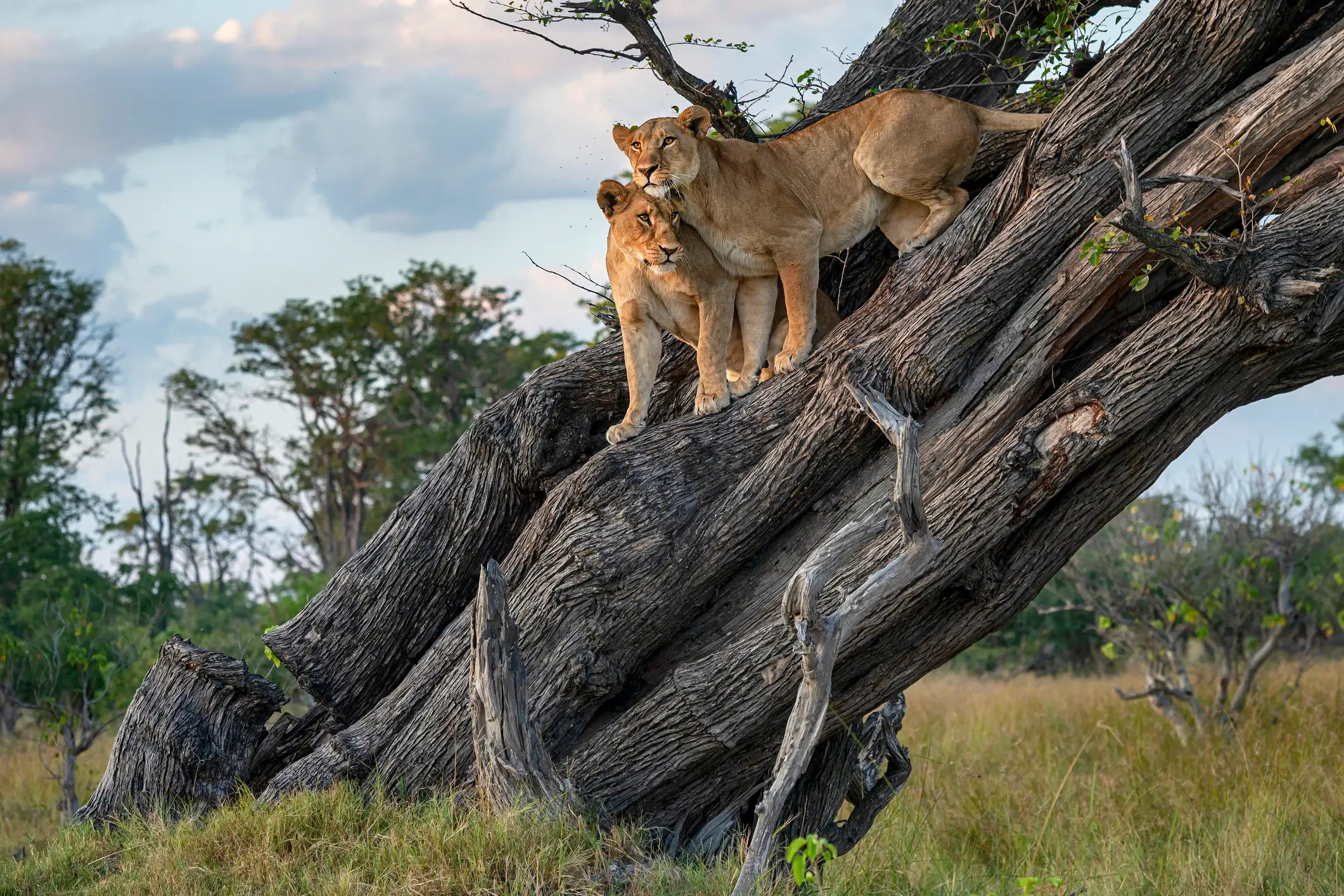
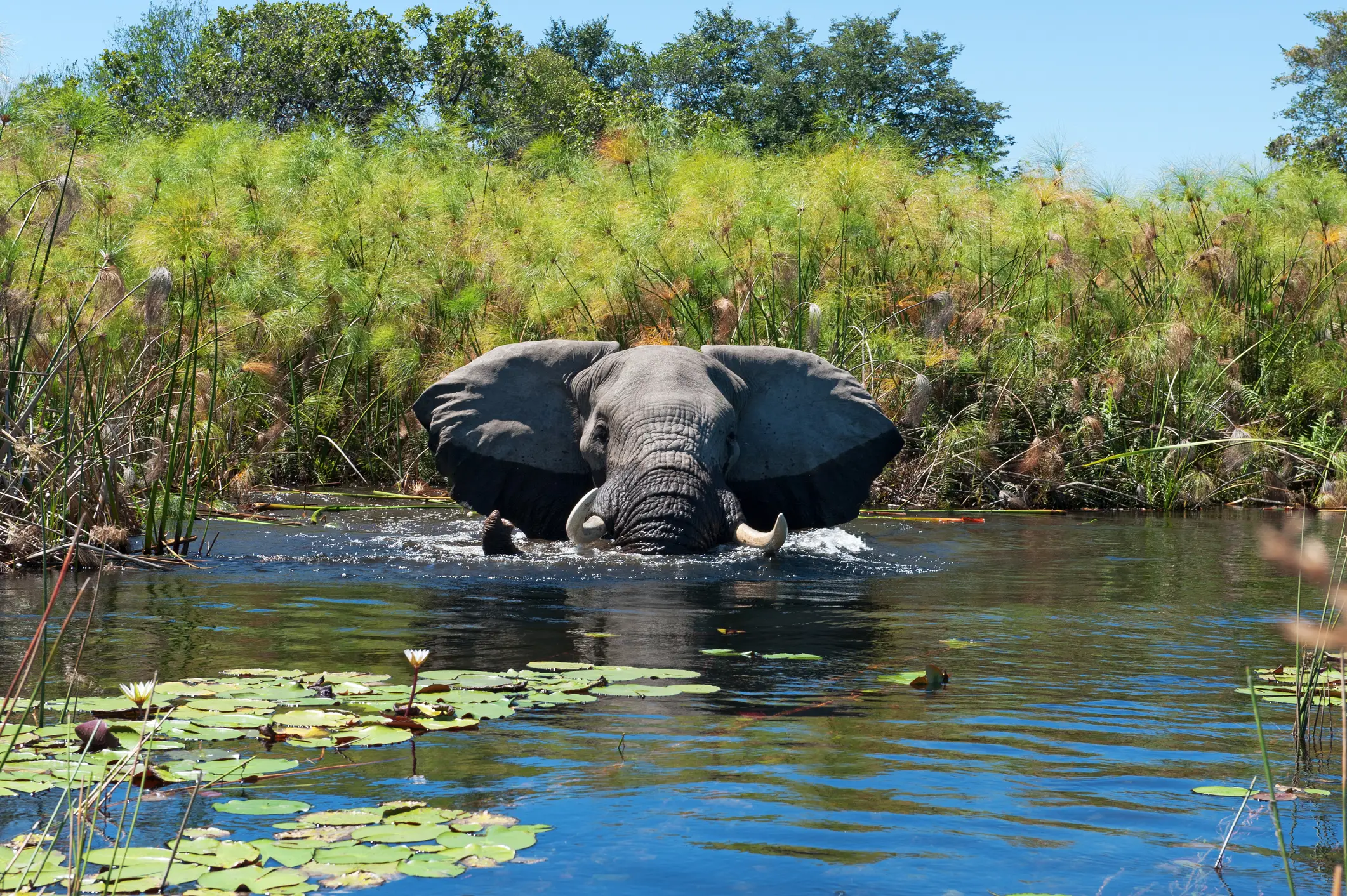
More wildlife adventures across Africa
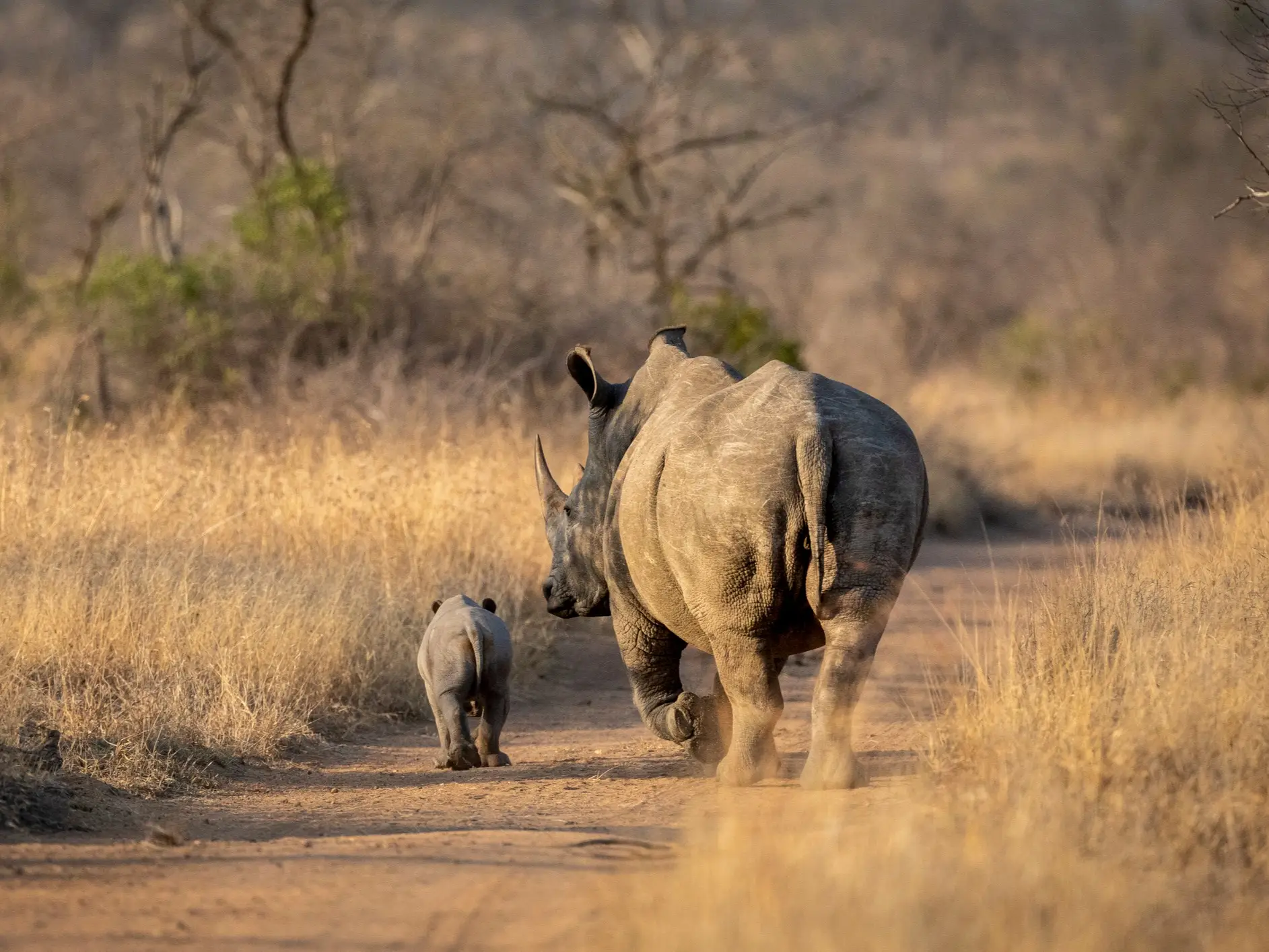
Safari in South Africa
South Africa is perfect for a first safari: easy to reach, well-managed, and incredibly diverse. Kruger National Park combines one of Africa’s best visitor infrastructures with serious wildlife credentials: 800+ species and lodging that ranges from park-run camps to high-end lodges. A day pass is about $29.
Prefer something more compact? Pilanesberg National Park, northwest of Johannesburg, is malaria-free, easy to access, and perfect for a short safari taste. Day passes are around $6.
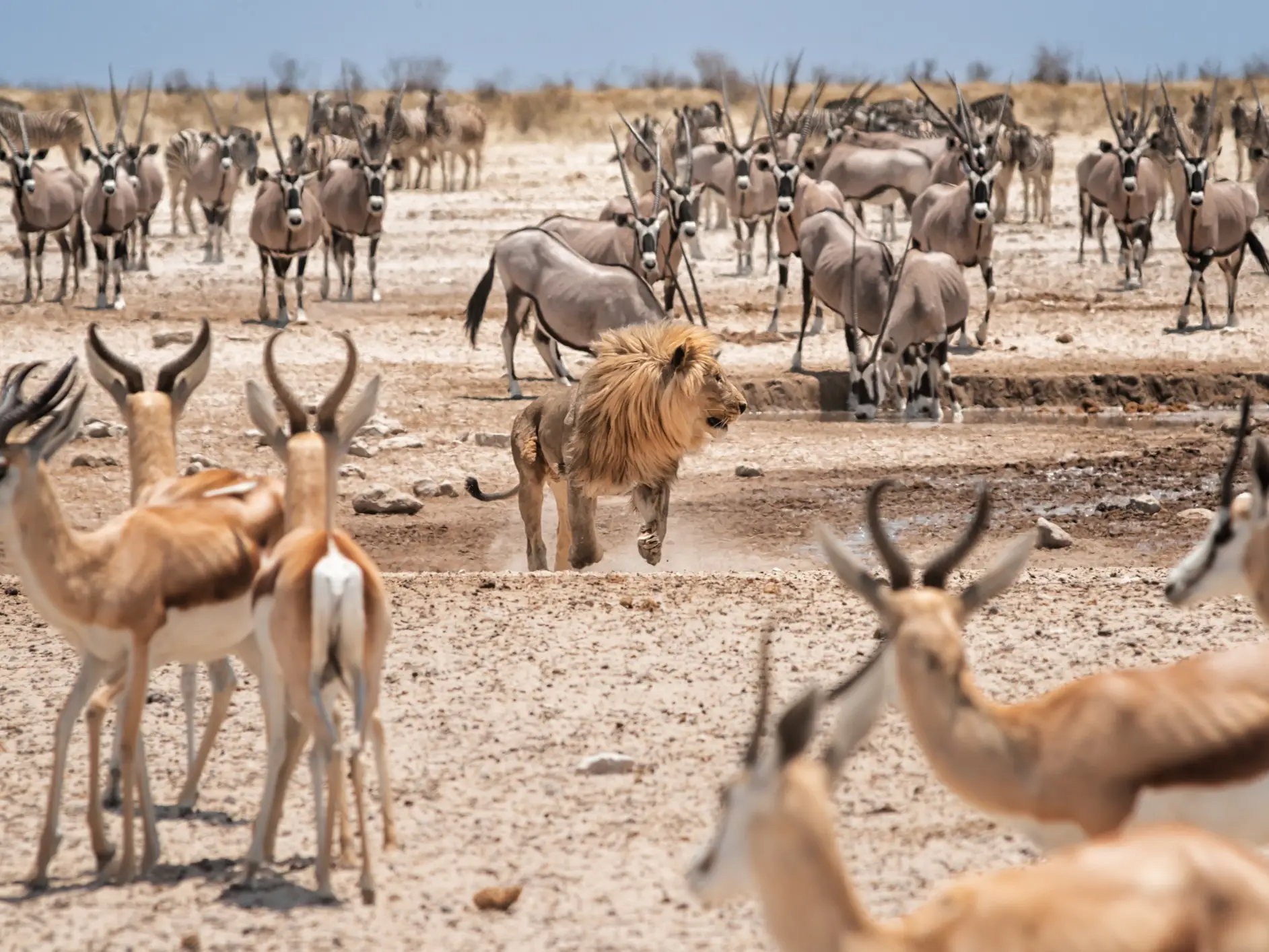
Safari in Namibia
Namibia is vast, quiet, and almost empty of people, ideal for travelers seeking space and stillness. In Etosha National Park (day pass about $9), safari centers on the great Etosha Pan, where giraffes, rhinos, oryx, and countless other species gather at the waterholes.
The country’s crystal-clear days and brilliant, star-filled nights—paired with its wide-open plains—make Etosha a dream destination for photographers. For those who love nature and solitude, this is safari at its purest.

Safari in Uganda
Uganda combines classic safari with lush tropical scenery and dramatic mountain vistas. In Queen Elizabeth National Park (day pass about $50), the headliners are tree-climbing lions—plus boat safaris on the Kazinga Channel, where hippos and buffalo pack the banks.
It’s also the gateway to mountain gorilla trekking in Bwindi Impenetrable Forest, one of Africa’s most powerful wildlife experiences. If you’re after variety, Uganda delivers both savanna safari and jungle in one trip.
Wildlife Adventures Beyond Africa
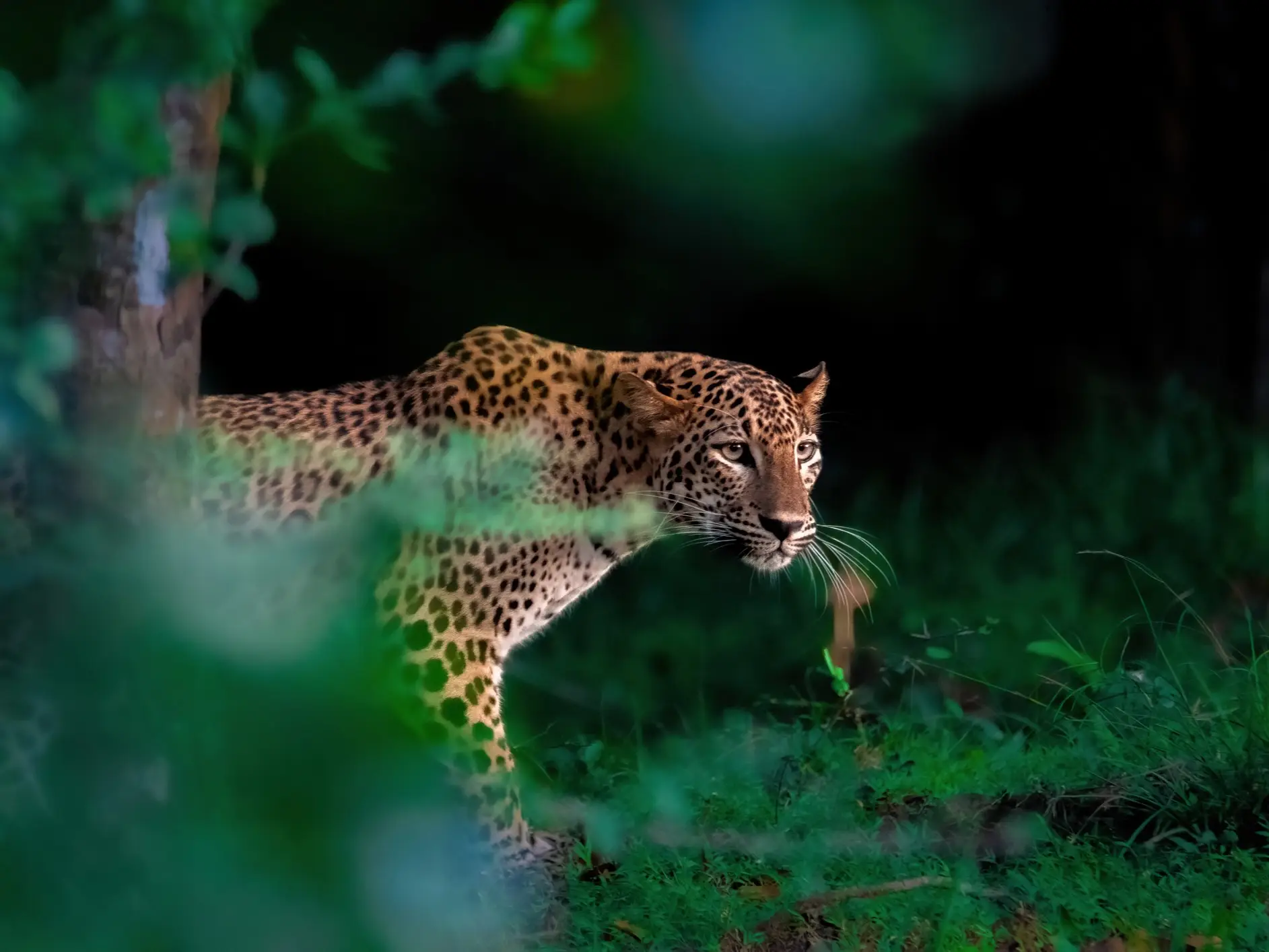
Sri Lanka
Jungle, grasslands, lakes, and true wilderness—Sri Lanka packs a lot into a small space. Standout parks include Yala, Udawalawe, Minneriya, and Wilpattu. Expect frequent sightings of Asian elephants, especially in the dry season when they gather at scarce waterholes, plus the Sri Lankan leopard, water buffalo, wild boar, and a rich birdlife. Explore it all by boat or shoreline safaris on rivers and lakes, jungle hikes, or game drives through dense forest, always close to the animals’ tracks.
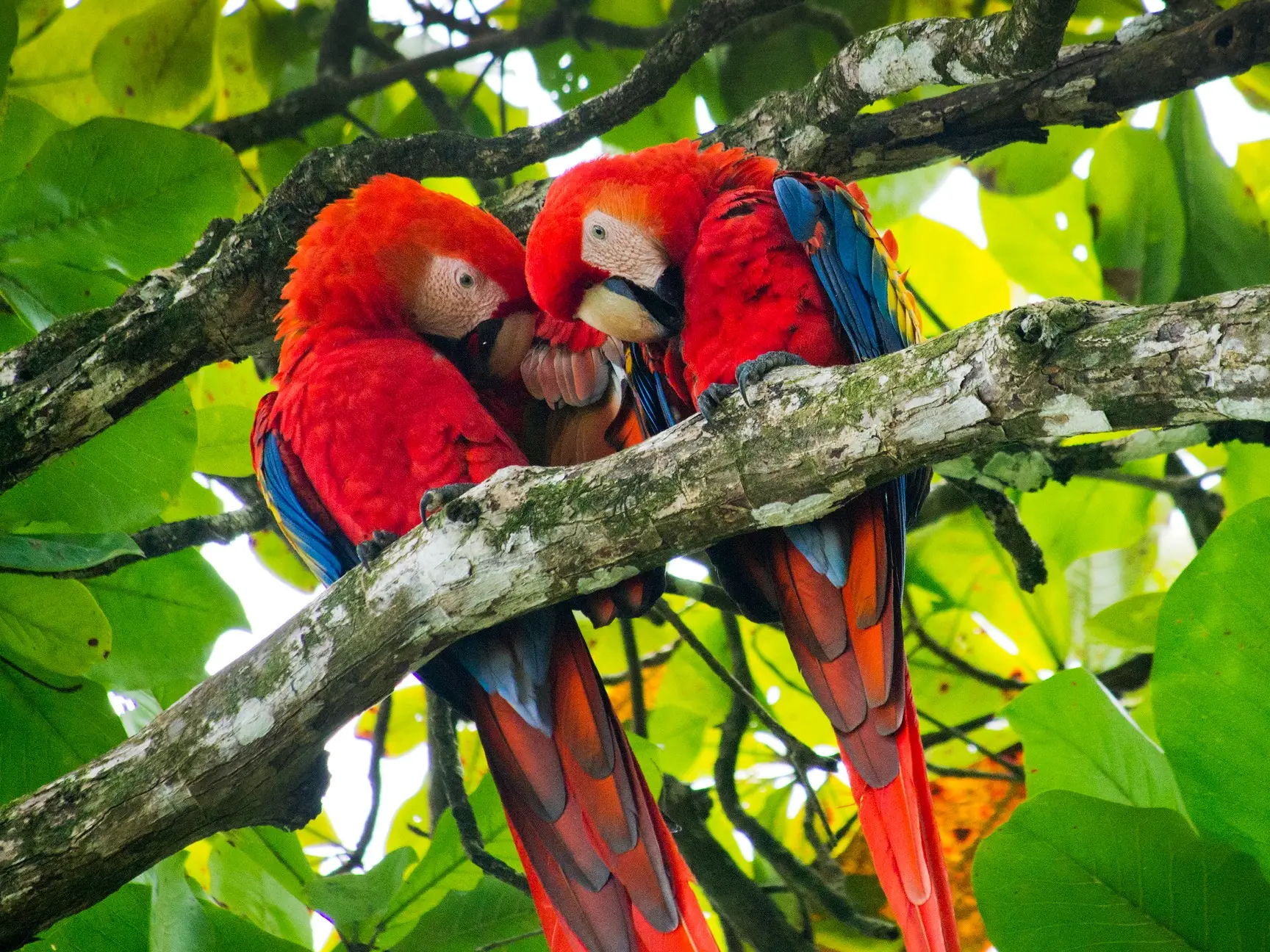
Costa Rica
Costa Rica is a paradise for wildlife lovers—rainforests, mangroves, and two tropical coasts form a lush, living mosaic. In national parks like Corcovado, Tortuguero, Manuel Antonio, and Palo Verde, you can spot howler monkeys, sloths, crocodiles, iguanas, and a dazzling array of bird species. From July to October, humpback whales and their calves pass close to the Pacific coast, offering some of the region’s best whale-watching experiences. In Costa Rica, safari takes on a new meaning—not in a jeep across dry plains, but on foot or by boat through vibrant tropical wilderness.
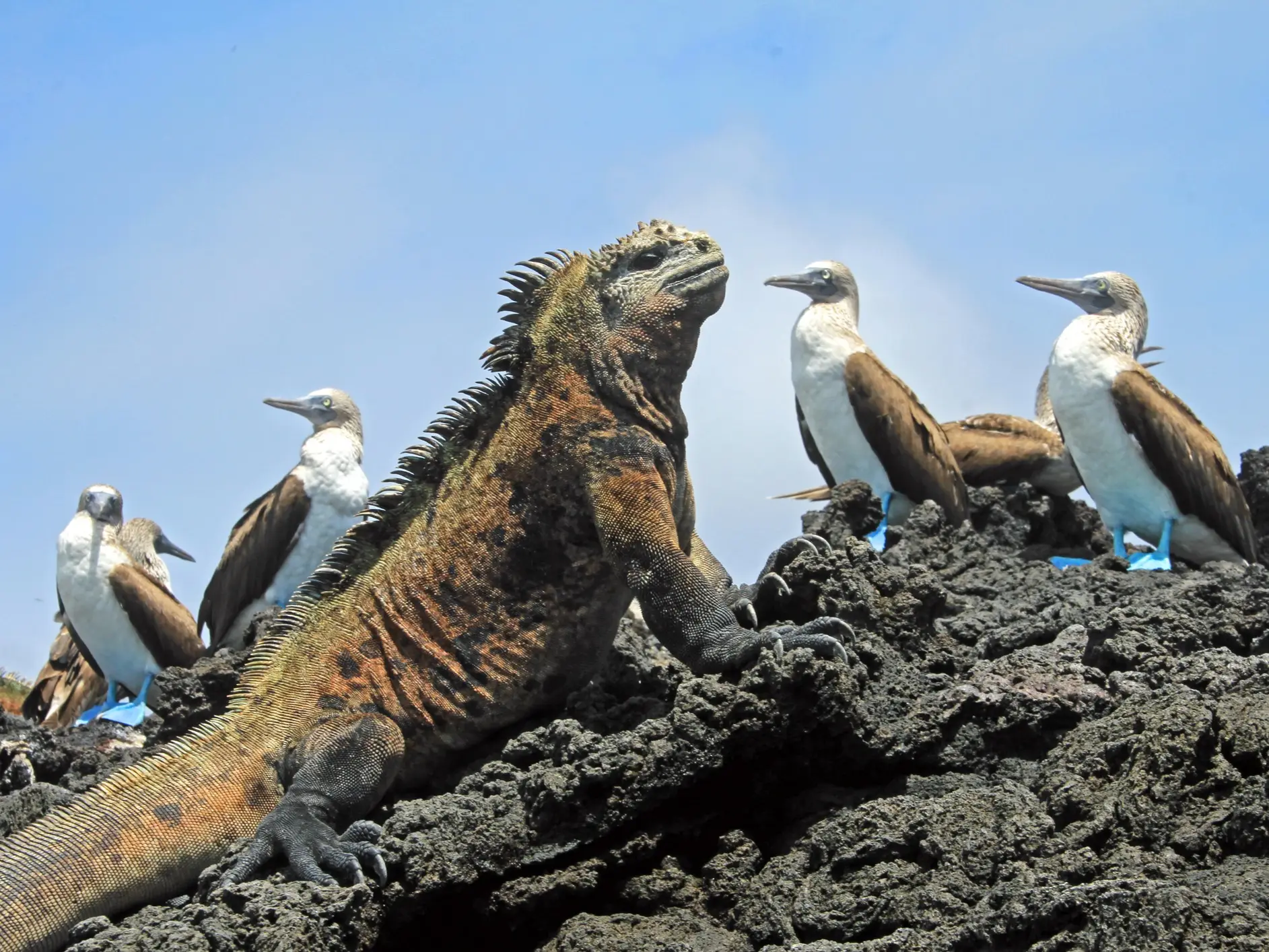
Ecuador
Ecuador packs an incredible range of landscapes into a small area—rainforest, Andes, and Pacific coast combine into a true micro-adventure for wildlife lovers. In rainforest regions such as Yasuní National Park and Podocarpus, lucky visitors may spot jaguars, tapirs, anteaters, and monkey species found nowhere else. Out on the Galápagos Islands, giant tortoises, marine iguanas, and seabirds roam freely in their natural habitat. Traveling here means encountering wildlife up close—on boat trips, guided jungle walks, and through unforgettable moments both on land and underwater.
Methodology
The 50 national parks and wildlife reserves featured in the index represent an expert-curated selection of destinations especially suited for safaris and wildlife viewing. Only parks in countries where travel is feasible and considered sufficiently safe for responsible tourism were included.
Day pass (Entry Fee): Recorded the official per-day entrance fee for one adult international visitor. If multiple tariffs were listed, the peak-season rate was used for comparability. Only the base park entry fee counted; separately listed add-ons (e.g., concession/lodge, vehicle, guide, camping) were excluded. Cheaper = better.
Overnight stay: Checked whether overnight stays are permitted inside park boundaries at designated sites (e.g., campgrounds, park-run camps, lodges).
Big Five presence: Recorded how many of the Big Five species—lion, elephant, buffalo, leopard, and rhino—are found in each park. Sources included official park information and reliable tourism and conservation data. The more species present, the higher the score.
Biodiversity: The total number of documented animal species per park was recorded – with a focus on mammals and birds, supplemented by reptiles, amphibians, and larger insects (where available). Sources: official park websites and public conservation databases. The higher, the better.
Nature Conservation: Qualitative classification as “sustainably managed” (100 points) or “questionable managed” (50 points) based on: anti-poaching & ranger presence, stability/size of central populations (especially elephant, rhino), governance & funding (state, NGOs, community), human-wildlife conflicts (encroachment, conflicts, habitat fragmentation, tourism pressure), and ecological integrity (connectivity, habitat condition).
Best Travel Time: Months with the best conditions for wildlife observation were recorded, based on animal visibility and park accessibility. Peak season was defined as periods when dry seasons or seasonal migrations enable optimal observations. Rating: The longer the high season, the better.
Risk: This criterion is based on Numbeo's crowd-sourced Safety Index, which ranks countries according to the subjective sense of security of residents and travelers. A higher index value indicates a higher perceived level of safety. Rating: The safer the country, the better the result.
Ranking: The overall evaluation was carried out using a point system (10–100 points, unless otherwise specified). All factors were weighted equally. The park with the highest total score ranks first in the Safari Index. All information refers to the time of the study in September 2025 and was carefully researched and checked for plausibility.